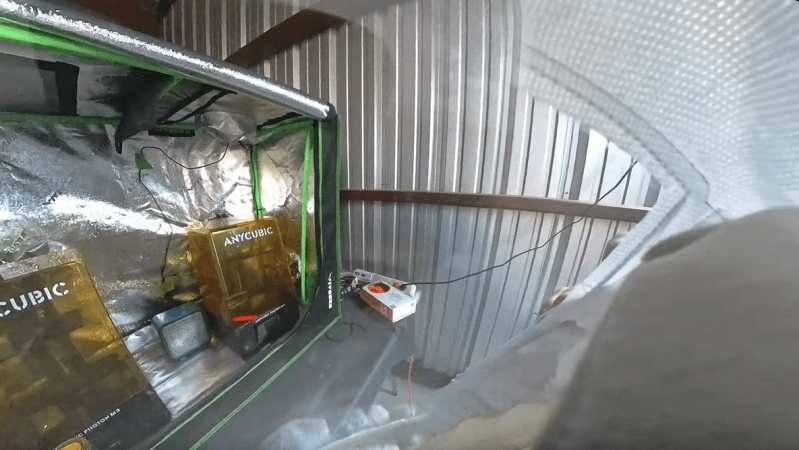The smell of resin SLA printing is like the weather — everybody complains about it, but nobody does anything about it. At least until now, as [Aris Alder] tackles the problem with an affordable DIY supplied-air respirator.
Now, we know what you’re thinking, anything as critical as breathing is probably best left to the professionals. While we agree in principle, most solutions from reputable companies would cost multiple thousands of dollars to accomplish, making it hard to justify for a home gamer who just doesn’t want to breathe in nasty volatile organic compounds. [Aris] starts the video below with a careful examination of the different available respirator options, concluding that a supplied air respirator (SAR) is the way to go.
His homebrew version consists of an affordable, commercially available plastic hood with a built-in visor. Rather than an expensive oil-free compressor to supply the needed airflow, he sourced a low-cost inline duct fan and placed it outside the work zone to pull in fresh air. Connecting the two is low-cost polyethylene tubing and a couple of 3D printed adapters. This has the advantage of being very lightweight and less likely to yank the hood off your head, and can be replaced in a few seconds when it inevitably punctures.
Another vital part of the kit is a pulse oximeter, which [Aris] uses to make sure he’s getting enough oxygen. His O2 saturation actually goes up from his baseline when the hood is on and powered up, which bodes well for the system. Every time we pick up the welding torch or angle grinder we wish for something like this, so it might just be time to build one.
Thanks to [Zane Atkins] for the tip.
















Respiration aspirations
He really breathed life into that one
Neat presentation, but I thought continuous pressure systems required specially tuned exhalation valves so that the CO2 gets flushed out when you exhale. Continuously monitoring your O2 levels with a finger oximeter seems like a bad idea in a work environment.
More to the point, if a 3M full face mask with dual organic gas / acid gas filters (~$100) isn’t adequate for resin printing I kinda wonder if there’s something wrong with your resin.
On a CPAP machine that valve is a bunch of holes. And that’s for a mask sealed directly to the airways.
I think if you aren’t underwater the requirements are much simpler, and you aren’t even trying to force the airways open here so the pressure can be even less and leakier.
On the other hand, ur not sleeping.
So you need more air in and faster outflow.
With simple holes and crappy flow, you will suck vapors on every breath.
This is another case of someone reinventing the wheel without studying the state of the art.
Just go to the welding supply store. Your lungs will thank you.
Your time should not be treated as free, even if unemployed.
Hacker != Crank Reinventor
Valves are still handy on land whenever you’ve got a limited resource (air in a tank). The open circuit SCBA gear used by firefighters, hazmat, etc has valves which are quite similar to the ones in your standard off-the shelf full-face or half-face respirator… the firefighting ones I’ve used are essentially a really nice full-face respirator with a regulator plumbed in instead of a filter cartridge (and of course the backpack and air cylinder to feed it).
They also make escape SCBAs, which are basically a continuous flow hood hooked up to the same kind of tank tank. Good for maybe 5-15 minutes instead of 3-4 hours, which gives you an idea of how much more flow is needed when you don’t have valves *and* need to keep outside air out.
Nope, you’re probably thinking of something much fancier. These hoods don’t need valves at all- the hood has a less-than-perfect seal, so that air is constantly flowing out of it at the same rate that it’s flowing in (which is much faster than any CO2 can build up). This constant flow also maintains the constant positive pressure that keeps contaminated outside air from entering.
The organic/acid cartridges are great for what they do, but a) the carbon only reduces your exposure, it doesn’t eliminate it (depending on the specific scenario, even a brand new filter may only adsorb around 90% of the organic vapor passing through) and b) they’re consumable; even if you do nothing more than open the package, they’re only good for six months).
Provided you’re drawing from a source of clean air, the continuous pressure respirator needs no equivalent filter maintenance, and keeps out nearly 100% of *everything* that might be in your workspace atmosphere – no worries if it’s organic vapor, acid, particulate, or something even a carbon filter can’t handle.
Plus, even slightly cool and/or dry supply air for a nice fog-free view? Very nice. Comes second to running a massive air compressor and a vortex tube vest, but you can’t have everything, especially with efficiency.
A facemask isn’t suitable if you’ve got a beard; you can’t get a seal. It’s a big problem particularly for woodworkers as we tend towards the beardy.
You *can* get a seal – it just usually requires waxing up your beard along the seal line, which is a royal pain in the butt to get back out…
Petroleum jelly (AKA Vaseline), as long as your mask seal elastomer is not something degraded by petrochemicals (or you just replace the seal regularly as you should be doing anyway…).
Moot for PAPR/SAR/other positive-pressure supplied-air hoods where leaking is intended behaviour.
Or a big nose. I have been unable to find one which seals reliably so I have to resort to using tape to seal it.
Good project and great write up.
Basically putting a fan on a hose accomplishes all the goals- cheap, effective. Done.